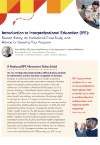How To: Seven Steps for Designing Interprofessional Education Curriculum and Professional Development
Designing effective interprofessional education (IPE)—whether in an academic setting, in authentic practice settings with real-world teams, or through professional development activities—requires thoughtful planning and collaboration. Organizers need not only establish learning outcomes but also how to facilitate learning in practice, identify collaborators, and work through logistics such as scheduling and funding.
A well-designed IPE experience is a key way in which students and professionals develop the skills to work on interprofessional teams. Watch this webinar by Dr. Jennifer B. Watson from Texas Christian University as she discusses the need for better IPE (not just more IPE), and shares strategies for building effective collaborative teams. Find out how IPE is preparing a “practice ready” workforce that understands how to work collaboratively with other professions to deliver the best patient care.
Getting Started: An IPE Checklist
This checklist guides you through how to design, implement, and evaluate the effectiveness of your IPE activity.
1. Identify potential collaborators.
The easiest place to find collaborators is within your own organization. Look across your institution or clinic, and connect with like-minded colleagues who share your interest and motivation to offer IPE. This can be as simple as reaching out to colleagues based on their job titles or raising the topic during staff meetings (see additional recommendations in 12 Tips for Developing Inter-Professional Education in Healthcare). Even if the person you contacted cannot help, they may be able to refer you to someone who can.
Focus on finding one or two collaborators at first. More is not necessarily better. In fact, students report less satisfaction when an IPE exercise involves professionals with whom they would not normally collaborate in real life. Look for collaborations that mirror real-life situations, such as the following:
- Vestibular/balance challenges (audiologist, otolaryngologist, and PT)
- Cleft palate team (audiologist, otolaryngologist, SLP, social worker)
- Stroke rehabilitation team (SLP, PT, OT, social worker)
- Early hearing detection and intervention (EHDI) team (audiologist, SLP, early intervention/preschool teacher, parent, otolaryngologist, teacher of the Deaf and hard of hearing)
- Early speech and language identification and intervention team (SLP, early intervention/preschool teacher, parent, otolaryngologist)
- Traumatic brain injury team (SLP, PT, OT, psychologist, social worker, physician, and/or neurologist)
Discuss mutual needs, interests, and goals with potential collaborators. Creating an IPE exercise requires ongoing collaboration with your partner(s). It’s important to have an initial discussion to ensure that you are on the same page and to plan next steps. Get started by asking the following questions:
- Are there mutual areas of interest and need for IPE collaboration?
- Have you and your partner both identified the same gaps in learners’ competencies? Do you agree on the best way to address them?
- What are your vision and goals for IPE? Do you and your partner share a similar vision and common goals?
- How are you currently implementing IPE—and with whom? Share examples of existing collaboration(s), and request to further explore current, additional, and future opportunities.
- Do you know of additional professions, stakeholders, or IPE champions who are interested in meeting and discussing next steps?
Connect with potential collaborators outside your organization. If you need to look outside your organization to find a collaborator, the organizations below provide opportunities to connect with subject-matter experts to exchange IPE ideas or experiences. Most of these organizations also offer IPE-focused conferences and disseminate the latest IPE research in peer-reviewed journals.
- Council of Academic Programs in Communication Sciences and Disorders (CAPCSD)
- National Center for Interprofessional Practice and Education
- Interprofessional Education Collaborative (IPEC)
- American Interprofessional Health Collaborative (AIHC)
- National Academies of Practice (NAP)
2. Get to know your learners.
With your goal in mind, the next step is learning more about what your learners need to accomplish that goal. You might want to do some learner interviewing or surveying. What additional skills do your learners say they need? If available, combine those results with relevant data from other sources such as electronic medical records, outcome measures.
Consider your learners’ level of familiarity with the material before designing your experience. This can be tricky when you are working with learners across different professions. For example, professions may address topics at different times, requiring IPE activities to accommodate learners with different levels of IPE experience. If this is the case, be sure to provide learners with clear ground rules and expectations. The Kirkpatrick outcomes typology (Table 3-1, page 33; PDF available for free download) can guide you in planning appropriate activities. For example, novice learners may simply be exposed to IPE ideas, whereas intermediate learners focus on the application of knowledge and skills in practice. Advanced students focus on competency in specific skills.
3. Identify learning outcomes.
Designing an IPE exercise starts with defining your learning outcomes. These will depend on your IPE exercise and the audience’s learning needs. Select up to three IPEC Core Competencies across the four categories listed below.

Values and Ethics: Work with team members to maintain a climate of shared values, ethical conduct, and mutual respect.

Roles and Responsibilities: Use the knowledge of one’s own role and team members' expertise to address individual and population health outcomes.

Communication: Communicate in a responsive, responsible, respectful, and compassionate manner with team members.

Teams and Teamwork: Apply values and principles of the science of teamwork to adapt one's own role in a variety of team settings.
In an academic setting, you may choose to focus on a skill that isn’t well addressed in the standard curriculum—for example, the authors of 12 Tips for Developing Inter-Professional Education in Healthcare found that patient handoffs were not well taught in medical education. To address this gap, they created a handoff workshop for undergraduate students from several health care professions.
Or consider this example for integrating IPE into a university-wide core curriculum for undergraduate students and this Toolkit to accelerate solutions-oriented IPE that is demonstrating impact and results.
Many of the same principles for planning new lPE activities apply not only to university-level students but also to professionals in the workforce. ASHA’s Continuing Education webpages have resources for creating professional development and related learning outcomes. Check out ASHA’s resources for planning continuing education activities.
4. Plan and design your IPE experience.
The next step is to plan the activities that will help your students [PDF] achieve the learning outcomes. IPE can include a mix of coursework, simulations, clinical learning environments, and outreach to the communities of those in need.
Make sure that whatever you design is truly IPE, not simply “shared learning.” IPE is not different professions taking a class or workshop together. It is different professions collaborating and learning “about, from, and with” each other. Learning in this way supports the development of trust and teamwork—and reduces any chances of miscommunication across teams.
Make IPE authentic by pulling from real-life experiences.
For IPE to be meaningful and relevant, it must be authentic. The best way to accomplish this is to pull from real-life experience. Instructors often use case studies to teach clinical skills—and this goes for IPE, too. For example, this case study featuring a 60-year-old man with hearing loss [PDF] was transformed into an IPE activity by adding a lesson and discussion questions. In another example, this case study examines how a university’s health care-related programs developed an IPE experience that re-created a disaster simulation. Students role-played “victims” and “responders” after a tornado. This exercise helped students learn about collaboration and health care services. For more real-life cases that can inspire IPE activities, check out ASHA’s IPE/IPP case studies.
Need more help? The University of Toronto Center for Interprofessional Education offers IPE tools and resources, the Interprofessional Professionalism Collaborative (IPC) offers an Interprofessional Professionalism Assessment (IPA) Tool Kit with case scenarios, and the Center for the Advancement of Interprofessional Education (CAIPE) offers an interprofessional education handbook for educators and practitioners.
Watch this ASHA presentation, and learn proven strategies to create and deliver an impactful learning experience that will support your learner’s ability to gain and apply the new knowledge and skills.
5. Figure out the practicalities of running your IPE activities.
You planned the learning outcomes and curriculum. Now it’s time to figure out how to make your IPE exercise a reality. This step involves tackling logistical issues like scheduling and funding.
An IPE program can range from a 1-day exercise to a formally structured program with a well-defined administrative and operational structure. According to a survey by the AIHC and the National Center for Interprofessional Practice and Education, many universities are moving toward IPE programs with a dedicated staff, budget, and plan.
Tips for starting an IPE program from scratch.
As a first step, consider assessing your institution's capacity for high quality IPE using the 20-item IPEC Institutional Assessment Instrument (IAI). The IAI identifies institutional characteristics associated with successful implementation of high-quality programmatic interprofessional education (IPE) such as institutional infrastructure, institutional commitment, and IPEC competency framework.
If you are starting from scratch, be sure to set achievable goals. For example, if you are leading the push for IPE at your workplace or academic institution, start with a plan that has low expenses and uses limited resources. Even if your university or workplace is initiating the drive for IPE, a one-off event can be a good starting place. For example, the University of Nebraska Medical Center (UNMC) now has a state-of-the-art IPE program complete with a multi-million dollar educational technology and simulation facility. But its IPE program started in 2008 with a one-off IPE panel discussion. To learn more about how UNMC grew their IPE program, read this case study [PDF] from UNMC. Also, consider making your IPE exercises optional—at least at first. For example, start by advising stakeholders to read 12 Tips for Developing Inter-Professional Education (IPE) in Healthcare. This can make scheduling easier and keep the group to a more manageable size. It will also ensure that you have willing participants who are eager to learn.
University of Nebraska Medical Center (UNMC)
Case study from Devin Nickol, MD [PDF]
How to schedule a successful IPE exercise.
When scheduling your IPE exercise, keep a few points in mind.
- Always allow space for informal conversations between students during your exercise, such as breaks for lunch and opportunities for discussion. Researchers found these casual interactions to be just as important as the actual exercise.
- For workplace professional development, one of the greatest barriers to IPE can be ensuring that staff have the time to prepare and focus. If not, you can end up with a group of people who attend simply to “check a box,” as one study found.
- Be sure that staff take a break from their normal duties to focus on IPE.
- Finally, don’t rule out virtual options. Virtual training expands your options for collaboration and can relieve scheduling and space constraints. Learn how two institutions, Indiana University and Creighton University, transitioned their IPE program to fully online.
6. Assess the impact of the IPE experiences.
The goal of any IPE learning experience is for participants to gain the knowledge and skills they need to collaborate on interprofessional teams. When designing a new course, workshop, or activity, it’s vital to know whether it helped accomplish that goal—and get feedback for how you can improve in the future. This is where an evaluation plan comes in.
Assessment begins with a plan for what needs to be evaluated, how, and why. Even a simple IPE exercise should have a written plan. At the most basic level, this plan will define your evaluation questions and lay out how you will collect and analyze your data.
To learn more about creating an evaluation plan, visit the National Center for Interprofessional Practice and Education website to view this series of webinars covering best practices in creating and executing your evaluation plan.
7. Disseminate IPE results and lessons learned.
As part of advancing IPE, consider sharing your IPE implementation experience and outcomes with peers and faculty from other professions. Sharing your successes and challenges helps you and others in the field. Consider presenting your results at the many IPE/IPP-focused conferences or publishing your work in an IPE/IPP-focused publication. See our research page for a list of journals that publish IPE/IPP research.














